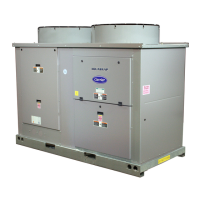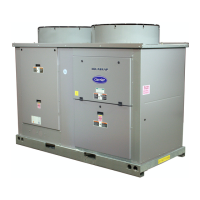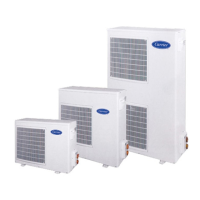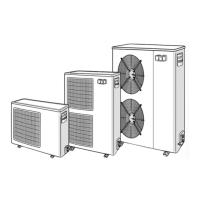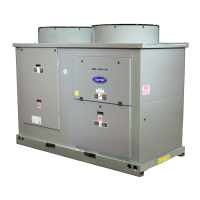Do you have a question about the Carrier 30RQ and is the answer not in the manual?
General safety advice for installation, start-up, and servicing.
Safety precautions related to electrical hazards and qualified personnel.
Overview of Pro-Dialog system for controlling chillers and heat pumps.
List of abbreviations used throughout the manual.
Overview of the control system components and user interface.
Details on the 24 VAC supply to the control boards.
Explanation of LED indicators for board operation and communication.
Types of sensors used for pressure and temperature measurements.
Describes controls for evaporator pumps, heater, and boiler.
Details terminal block connections for unit control and communication.
Explains volt-free contacts for unit control without multiplexing.
Explains volt-free contacts for unit control with multiplexing.
Describes volt-free contact for changing unit setpoints.
Explains demand limit contacts for energy management.
Explains demand limit contacts without energy management.
Describes the main and summary interfaces and their components.
Explains unit start/stop, operating types, and control methods.
Introduces the menu system for configuring the unit.
Describes how to navigate and select main menus using the MENU button.
Explains how to scroll through menu items using arrow buttons.
Details how to enter modification mode and adjust parameter values.
Explains how to expand parameter displays for more detail.
Details the items and descriptions within the Information menu.
Lists and describes available temperature readings.
Lists and describes available pressure readings.
Details the available setpoints and their configuration.
Lists and explains the unit's input signals and contacts.
Explains how to view output status and perform manual tests.
Covers general configuration menu, password, and sub-menus.
Overview of configuration types (Factory, Service, User).
Details password entry for configuration and test access.
Details configurable parameters for User 1.
Details configurable parameters for User 2.
Explains configuration settings for date, time, and summertime.
Describes timer programs for occupied/unoccupied modes and setpoints.
Details configuration of public holiday periods.
Covers configuring the unit for CCN broadcast and daylight saving time.
How to display and reset active alarms.
How to view the history of recorded alarms.
Introduction to runtime menus for tracking unit operation.
Details fan operating hours and other runtime data.
Describes maintenance scheduling and alerts.
Summarizes unit start/stop status based on operating type and parameters.
Explains automatic and manual heating/cooling/standby modes.
Details unit heating/cooling/auto selection based on control type and parameters.
Explains control of evaporator water pumps, including auto-rotation and periodic start.
Describes the function of the control interlock contact for safety.
Explains evaporator antifreeze protection using heaters.
Defines the control point and its relation to active setpoints and reset.
Explains how active setpoints are selected in different modes.
Describes how setpoints are modified based on load changes (reset function).
Explains how to limit unit capacity via contacts or mA input.
Details settings for night mode operation to reduce noise and capacity.
Explains how the system manages compressor stages for temperature control.
Describes head pressure control using fans, including variable speed options.
Explains the automatic defrost cycle for air heat exchangers.
Describes control of additional electric heating stages for heat pumps.
Explains boiler control for heat pumps when heat capacity is insufficient.
Details how two Pro-Dialog Plus units can be linked as master/slave.
Describes the function and control of the heat reclaim module.
Explains the direct-expansion free-cooling principle and its components.
Overview of the Pro-Dialog Plus fault tracing aid functions.
Explains how alarm LEDs and the Alarm menu indicate faults.
Describes the procedure for resetting active alarms.
Provides a detailed description of each alarm code and its cause.
General safety advice for installation, start-up, and servicing.
Safety precautions related to electrical hazards and qualified personnel.
Overview of Pro-Dialog system for controlling chillers and heat pumps.
List of abbreviations used throughout the manual.
Overview of the control system components and user interface.
Details on the 24 VAC supply to the control boards.
Explanation of LED indicators for board operation and communication.
Types of sensors used for pressure and temperature measurements.
Describes controls for evaporator pumps, heater, and boiler.
Details terminal block connections for unit control and communication.
Explains volt-free contacts for unit control without multiplexing.
Explains volt-free contacts for unit control with multiplexing.
Describes volt-free contact for changing unit setpoints.
Explains demand limit contacts for energy management.
Explains demand limit contacts without energy management.
Describes the main and summary interfaces and their components.
Explains unit start/stop, operating types, and control methods.
Introduces the menu system for configuring the unit.
Describes how to navigate and select main menus using the MENU button.
Explains how to scroll through menu items using arrow buttons.
Details how to enter modification mode and adjust parameter values.
Explains how to expand parameter displays for more detail.
Details the items and descriptions within the Information menu.
Lists and describes available temperature readings.
Lists and describes available pressure readings.
Details the available setpoints and their configuration.
Lists and explains the unit's input signals and contacts.
Explains how to view output status and perform manual tests.
Covers general configuration menu, password, and sub-menus.
Overview of configuration types (Factory, Service, User).
Details password entry for configuration and test access.
Details configurable parameters for User 1.
Details configurable parameters for User 2.
Explains configuration settings for date, time, and summertime.
Describes timer programs for occupied/unoccupied modes and setpoints.
Details configuration of public holiday periods.
Covers configuring the unit for CCN broadcast and daylight saving time.
How to display and reset active alarms.
How to view the history of recorded alarms.
Introduction to runtime menus for tracking unit operation.
Details fan operating hours and other runtime data.
Describes maintenance scheduling and alerts.
Summarizes unit start/stop status based on operating type and parameters.
Explains automatic and manual heating/cooling/standby modes.
Details unit heating/cooling/auto selection based on control type and parameters.
Explains control of evaporator water pumps, including auto-rotation and periodic start.
Describes the function of the control interlock contact for safety.
Explains evaporator antifreeze protection using heaters.
Defines the control point and its relation to active setpoints and reset.
Explains how active setpoints are selected in different modes.
Describes how setpoints are modified based on load changes (reset function).
Explains how to limit unit capacity via contacts or mA input.
Details settings for night mode operation to reduce noise and capacity.
Explains how the system manages compressor stages for temperature control.
Describes head pressure control using fans, including variable speed options.
Explains the automatic defrost cycle for air heat exchangers.
Describes control of additional electric heating stages for heat pumps.
Explains boiler control for heat pumps when heat capacity is insufficient.
Details how two Pro-Dialog Plus units can be linked as master/slave.
Describes the function and control of the heat reclaim module.
Explains the direct-expansion free-cooling principle and its components.
Overview of the Pro-Dialog Plus fault tracing aid functions.
Explains how alarm LEDs and the Alarm menu indicate faults.
Describes the procedure for resetting active alarms.
Provides a detailed description of each alarm code and its cause.
| Brand | Carrier |
|---|---|
| Model | 30RQ |
| Category | Air Conditioner |
| Language | English |




